RGB and ARGB have become critical components in transforming mundane computer setups into captivating visuals.
RGB has been a longstanding favorite, transforming ordinary setups into stunning spectacles. However, with the appearance of ARGB technology, a new level of control and creativity has emerged.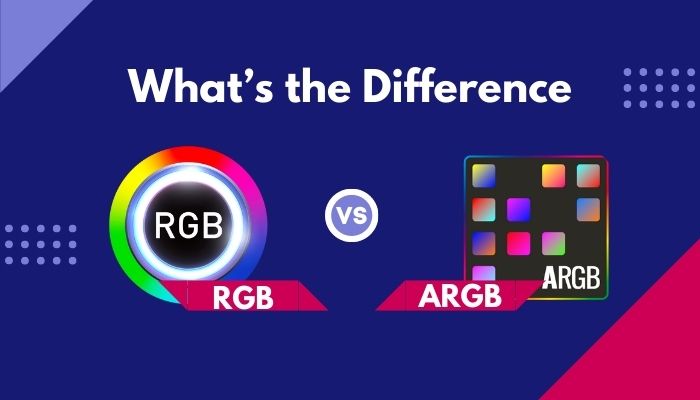
In this article, I’ll describe RGB and ARGB lighting, exploring their unique features, benefits, and the scenarios where they shine, ultimately shedding light on the choice between the two.
Let’s begin!
Feature Comparision Between RGB & ARGB
| Feature | RGB | ARGB |
|---|---|---|
| Definition | Uses Red, Green, and Blue LEDs to create various colors. | Allows individual control of each LED in a strip. |
| Lighting Effects | Static color, color cycle | Extensive range of dynamic effects like color chasing, rainbow, breathing, and more. |
| Control | All the lights are controlled as a group. | Each LED can be controlled separately. |
| Connection | Uses a 4-pin connector. | Uses a 3-pin connector. |
| Voltage | Requires 12 volts. | Requires 5 volts. |
| Price | Costs less than ARGB. | More expensive than RGB. |
What is RGB?
RGB stands for Red, Green, and Blue. It refers to the primary colors used in lighting, particularly on screens. Using these primary colors, each tiny LED within an RGB strip can create an extensive spectrum of hues, allowing us to visualize captivating shades.
Although RGB lighting, whether it be in case fans or LED strips, remains constant in color, it offers the flexibility to modify and change the color composition.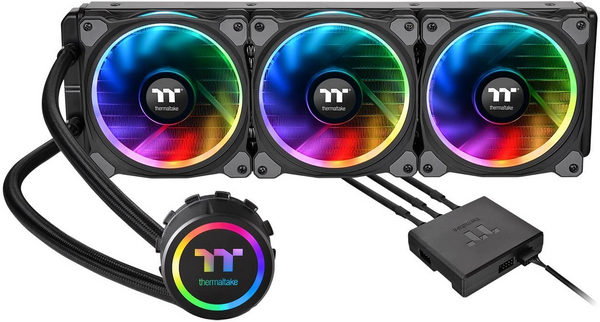
Unless the desired color is purple, each LED will simultaneously emit the same vibrant hue.
Limitations of RGB Lighting
RGB lighting enables diverse lighting modes, such as strobing and elegant fading between colors. But it does have its limitations when creating dynamic lighting effects compared to the more advanced ARGB lighting effects.
Connectivity of RGB LEDs
Motherboard manufacturers often adopt a standard 4-pin connector, which requires 12 volts for RGB LED strips, conveniently positioned alongside an ARGB connector. But the availability and quantity of these connectors may vary among different motherboard models.
Apart from the direct connection through a motherboard, alternative methods exist for connecting RGB lighting. These include utilizing RGB controllers, using buttons integrated into computer cases, or even employing the convenience of a remote.
Enhancing Your Lighting Experience
To truly immerse yourself in a captivating visual journey, embrace the remarkable possibilities that ARGB lighting brings.
RGB undoubtedly offers a foundation of vibrant hues, but ARGB elevates the experience by introducing breathtaking lighting effects that leave a lasting impression.
What is ARGB?
ARGB, which stands for Addressable RGB, revolutionizes lighting effects by offering individual LED control. Unlike RGB lighting, where all LEDs in a strip display the same color, ARGB allows each LED to emit a distinct hue.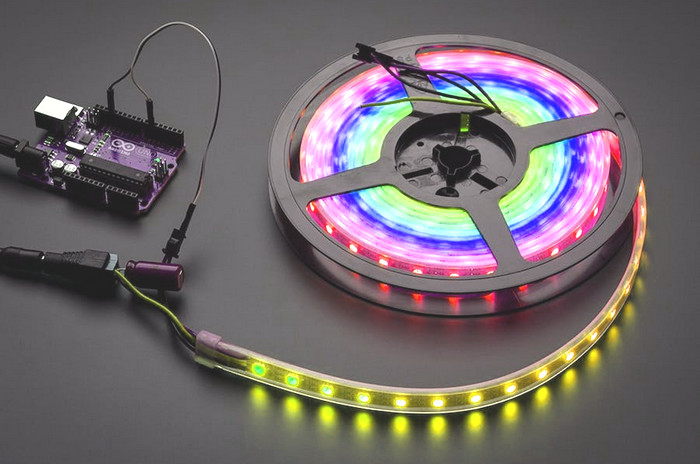
This groundbreaking feature means an ARGB strip comprising 50 LEDs can simultaneously showcase a mesmerizing blend of 50 vibrant colors, providing unique control and customization options.
Embracing the Modern Solution: ARGB Lighting
ARGB has become a more favorable lighting solution, finding its way into various components, including SSDs.
The individual LED control has allowed ARGB to create captivating lighting configurations, enabling users to design dazzling patterns such as spiraling rainbows, ethereal watercolor effects, glitch-inspired visuals, and much more.
Connectivity of ARGB LEDs
Similar to RGB lighting, ARGB components, and strips connect to motherboards using a standard connector. In most cases, it uses a 3-pin 5 volts connector, which closely resembles the RGB connectors but with the removal of one of the middle pins.
It is crucial to distinguish the voltage requirements, as mistakenly connecting a 5V ARGB device to a 12V RGB header will fry the ARGB connector instead of creating dazzling lighting effects.
Fortunately, motherboards typically label these connectors, making it straightforward to make the correct connection. 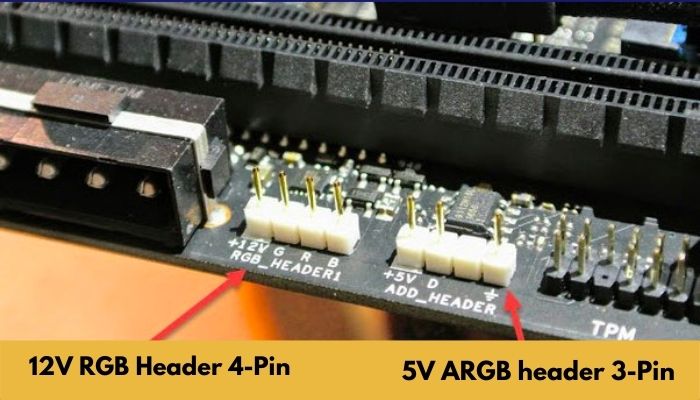
Elevate Your Lighting Experience
With ARGB lighting, the possibilities for captivating and personalized illumination are limitless. The ability to control each LED individually allows you to unleash your creativity and craft immersive lighting displays that elevate the aesthetic appeal of your PC.
ARGB or RGB, Which One is Better?
ARGB has taken the industry by storm as a more advanced form of RGB lighting, offering unique customizability and aesthetics. Gone are the days of static, monochromatic lighting. With ARGB’s individualized LEDs, you can unlock a world of possibilities.
These programmable LEDs allow you to create stunning spectral effects on every component of your PC setup. Picture your motherboard, graphics card, RAM, fan, keyboard, mouse, and headphones all synchronized in a mesmerizing dance of light. It’s a visual feast that elevates your PC experience to new heights.
you can also buy Aura Sync compatible RGB/ARGB LED strips separately and put them up where ever you want and control them however you want.
Also, ARGB has advanced software control, with leading programs like Corsair’s iCUE, or Asus Aura Sync, the power is in your hands to orchestrate a symphony of colors and effects.
But ARGB isn’t just about aesthetics. It also enhances your PC experience. When you’re playing games or listening to music, ARGB LEDs can mirror the visuals on your screen in real-time, taking you through a world of vibrant hues that respond dynamically to your activities.
When it comes to choosing between RGB and ARGB, the decision is clear. ARGB offers customization, precise control, and advanced visual effects that simply outshine its predecessor.
Does RGB or ARGB Affect Performance?
ARGB and RGB strips/devices have a negligible impact on your computer’s performance. These luminous lights draw power from the motherboard, which effortlessly supplies the energy needed to ignite the lights.
As a result, they don’t strain the computing or processing capabilities of the CPU, leaving performance untouched and unaffected.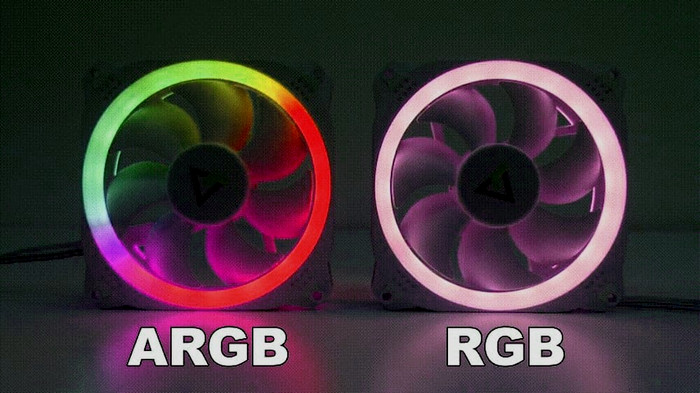
Performance concerns typically arise when components demand substantial processing power, such as the processor or graphics card, demand substantial processing power.
Fortunately, ARGB/RGB devices connect directly to the motherboard or through an adapter, bypassing the need to interact with the graphics card or processor. Thus, you can create magnificent lighting effects without worrying about any performance compromises.
It’s also true that specific RGB and ARGB devices utilize drivers and run as processes on your computer. Still, the processing power they consume is so low that it doesn’t impact your system’s performance in any way.
So, embrace the symphony of colors, and indulge in the atmosphere the ARGB creates, all while experiencing peak performance.
Is ARGB or RGB More Expensive?
When considering the extensively available products, the cost of devices featuring RGB or ARGB lighting technology can vary significantly. When it comes to RGB RAM, the cost tends to be higher compared to standard RAM.
Conversely, there is typically little price difference between an RGB-lit keyboard and a non-RGB keyboard.
However, there isn’t a substantial difference when comparing ARGB products’ pricing to standard RGB products. Although ARGB products may be slightly more expensive than RGB products, the price variation is not significant.
Due to its advanced technology and higher manufacturing costs, ARGB lighting generally carries a higher price tag than RGB lighting. The exact price difference can vary based on the brand and the particular device you’re purchasing.
A quick search on Amazon reveals that even when looking for RGB-specific products, many ARGB options appear as well.
It’s clear that RGB lighting is gradually being replaced by ARGB products, which are gaining popularity.
Whether you’re seeking RGB or ARGB lighting, consider the brand and device that best fits your needs and budget. Embrace the evolution of lighting technology and find the perfect illuminated setup for your computer parts.
Are the RGB Header and the ARGB Header Identical?
The RGB and ARGB headers look the same. But beware! Mixing up the RGB Header and the ARGB Header is a recipe for trouble. The RGB Header, radiating 12V power, features 4 pins for RGB devices. In contrast, the ARGB Header operates on 5V, with 3 pins dedicated to ARGB connections.
While the pins may appear similar, RGB Headers typically have an extra pin compared to ARGB Headers. This extra pin distinction is crucial to avoid confusion.
Voltage matters greatly! ARGB devices require 5 volts of electricity. So, connecting them to 12V RGB sockets, whether accidentally or intentionally, can damage both the device and the motherboard.
Thankfully, motherboard manufacturers make it easy to tell the difference. Look for labels, such as 12V or 5V, near the pins.
When in doubt, consult your motherboard’s manual, which is often accessible online.
Can You Plug RGB Into ARGB?
RGB and ARGB headers are not interchangeable due to voltage and signal differences. RGB devices require a 12V analog signal, and ARGB headers deliver a 5V digital signal. Fortunately, adaptors exist to bridge this gap, allowing you to connect RGB devices to ARGB headers on your motherboard.
Also, consider using RGB splitters or controllers to enhance your RGB setup further. These handy tools extend your motherboard’s native support, enabling you to connect and control multiple RGB devices simultaneously.
Here’s the list of the best RGB/ARGB Splitter cables you can purchase right now!
However, it’s important to note that most controllers typically require you to choose a single pattern or color, as they can not change hues through software.
So, while controllers offer versatility in connecting multiple devices, their color customization options may be limited.
Which Should You Get: ARGB or RGB?
ARGB offers all the functionalities of RGB with remarkable bonus features that will leave you fascinated. Its individually addressable LEDs grant unmatched control and precision, surpassing the limitations of RGB technology.
If cost and motherboard compatibility do not cause any issues, the choice between RGB and ARGB becomes a no-brainer.
With ARGB, you can effortlessly replicate the performance of an RGB device, discreetly displaying one mesmerizing color at a time.
In contrast, RGB falls short compared to the sheer customizability of ARGB. It has individually addressable LEDs, allowing for unparalleled control and precision.
Don’t worry about the abundance of RGB Headers on motherboards; controllers and splitters easily overcome any limitations. The possibilities are limitless with ARGB, from vibrant rainbows to subtle gradients. Utilize ARGB today and unlock a new level of PC customization.
FAQs
Which devices have ARGB and RGB lighting features?
In 2023, everything in your PC supports RGB and ARGB lighting, including Motherboards, RAMs, Graphics cards, CPU coolers, SSDs, Fans, Keyboards, Mice, Casings, and Power supplies.
Can ARGB and RGB increase FPS while gaming?
ARGB and RGB do not increase FPS while gaming. It’s just a hoax. ARGB and RGB just add some cool effects to your systems and give pleasure to your eyes. You can only show off your rig with fabulous color effects, but it won’t add any extra performance boost to your system.
Can I run 5V RGB from the 12V header?
No, running a 5V RGB from a 12V header is not recommended. You may end up with a burned component if you do that. But to do this, you should use a converter to run a 5V RGB from a 12V header. You can achieve a synchronous lighting effect by doing this.




